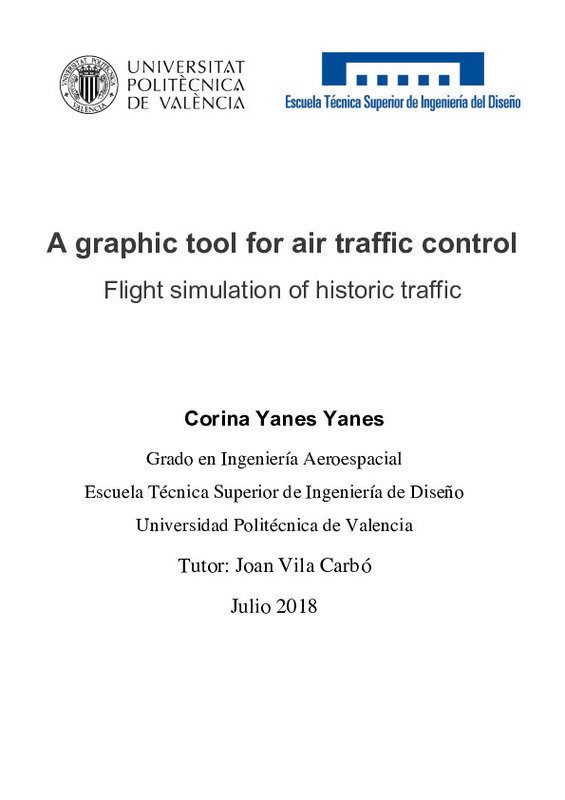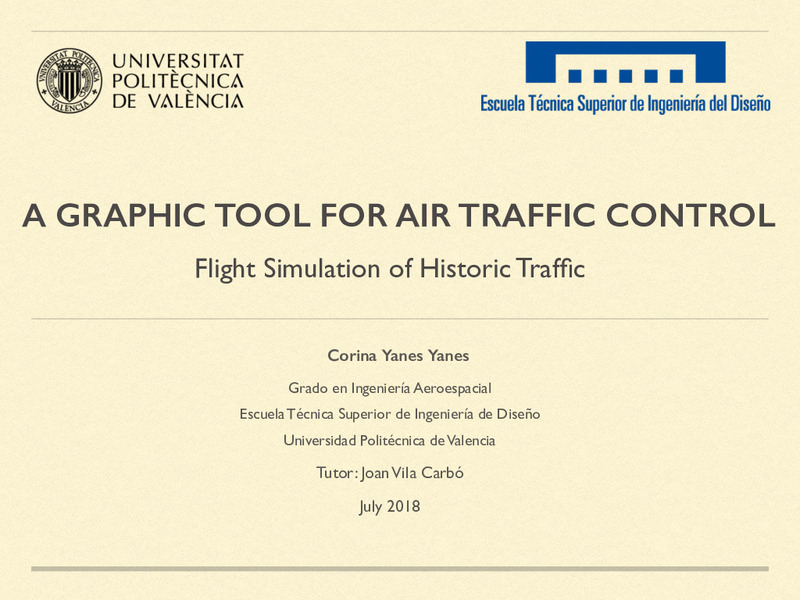JavaScript is disabled for your browser. Some features of this site may not work without it.
Buscar en RiuNet
Listar
Mi cuenta
Estadísticas
Ayuda RiuNet
Admin. UPV
Herramienta gráfica para el control del tráfico aéreo.Simulación de vuelo de tráfico histórico
Mostrar el registro sencillo del ítem
Ficheros en el ítem
| dc.contributor.advisor | Yuste Pérez, Pedro
|
es_ES |
| dc.contributor.advisor | Vila Carbó, Juan Antonio
|
es_ES |
| dc.contributor.author | Yanes Yanes, Corina
|
es_ES |
| dc.date.accessioned | 2018-10-26T10:52:22Z | |
| dc.date.available | 2018-10-26T10:52:22Z | |
| dc.date.created | 2018-07-26 | |
| dc.date.issued | 2018-10-26 | es_ES |
| dc.identifier.uri | http://hdl.handle.net/10251/111363 | |
| dc.description.abstract | [ES] The aim of the present project is to provide a graphical representation tool for traffic simulation. This tool is supposed to be able to simulate historic traffics from .so6 files provided by Eurocontrol. The purpose is to visualize and analyze Merge Point approaches and to provide the basis of a future tool for air traffic controllers which includes a relative position indicator. In the first part of this work, the objectives and program requirements for the tool to develop are specified. The second part gives the theoretical background of the Merge Point approaches and lists its advantages based on recent studies. For the total understanding of Merge Point and to provide some background knowledge, the concept of air space management is introduced and airspace structure and the kind of holdings that exist depending on the navigation method used (traditional or RNAV) are explained. To give an example, the Merge Point approach of Dublin Airport for runway 28 is described in more detail, as the same example is used as well for the use case in the third part of this work. All the tools and sources used for the development of the program are also introduced in this second part, including a short introduction in object oriented programming since the language used for the development of the program is Java 8. Finally, in the third part, the developed tool is explained and class interaction visualized by UMLs. A use case of Dublin Airport runway 28 was carried out and is included at the end of the program illustration in order to demonstrate its functioning. | es_ES |
| dc.format.extent | 118 | es_ES |
| dc.language | Inglés | es_ES |
| dc.publisher | Universitat Politècnica de València | es_ES |
| dc.rights | Reserva de todos los derechos | es_ES |
| dc.subject | Control de tráfico aéreo | es_ES |
| dc.subject | Programación gráfica | es_ES |
| dc.subject | Planes de vuelo | es_ES |
| dc.subject.classification | ARQUITECTURA Y TECNOLOGIA DE COMPUTADORES | es_ES |
| dc.subject.other | Grado en Ingeniería Aeroespacial-Grau en Enginyeria Aeroespacial | es_ES |
| dc.title | Herramienta gráfica para el control del tráfico aéreo.Simulación de vuelo de tráfico histórico | es_ES |
| dc.type | Proyecto/Trabajo fin de carrera/grado | es_ES |
| dc.rights.accessRights | Abierto | es_ES |
| dc.contributor.affiliation | Universitat Politècnica de València. Departamento de Informática de Sistemas y Computadores - Departament d'Informàtica de Sistemes i Computadors | es_ES |
| dc.contributor.affiliation | Universitat Politècnica de València. Escuela Técnica Superior de Ingeniería del Diseño - Escola Tècnica Superior d'Enginyeria del Disseny | es_ES |
| dc.description.bibliographicCitation | Yanes Yanes, C. (2018). Herramienta gráfica para el control del tráfico aéreo.Simulación de vuelo de tráfico histórico. Universitat Politècnica de València. http://hdl.handle.net/10251/111363 | es_ES |
| dc.description.accrualMethod | TFGM | es_ES |
| dc.relation.pasarela | TFGM\80103 | es_ES |
Este ítem aparece en la(s) siguiente(s) colección(ones)
-
ETSID - Trabajos académicos [8627]
Escuela Técnica Superior de Ingeniería del Diseño






![ZIP archive [ZIP]](/themes/UPV/images/zip.png)

